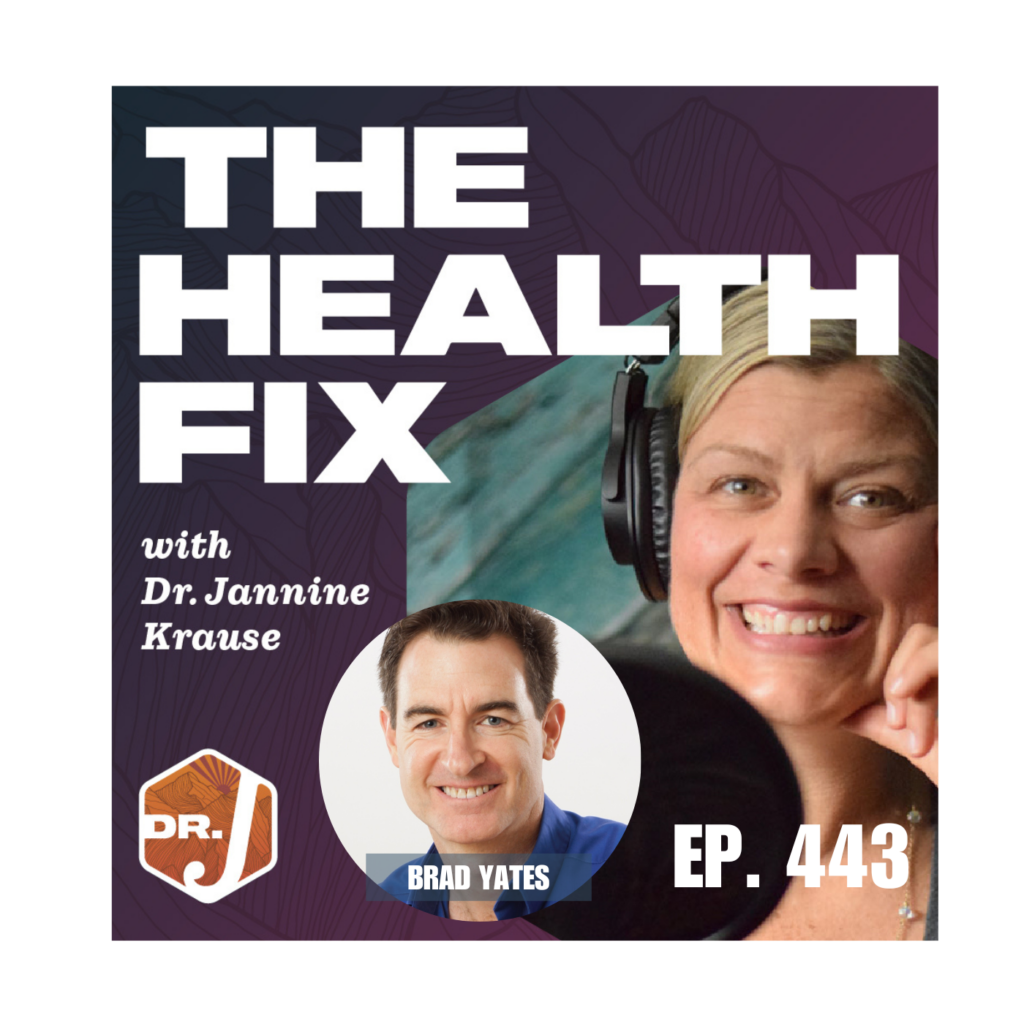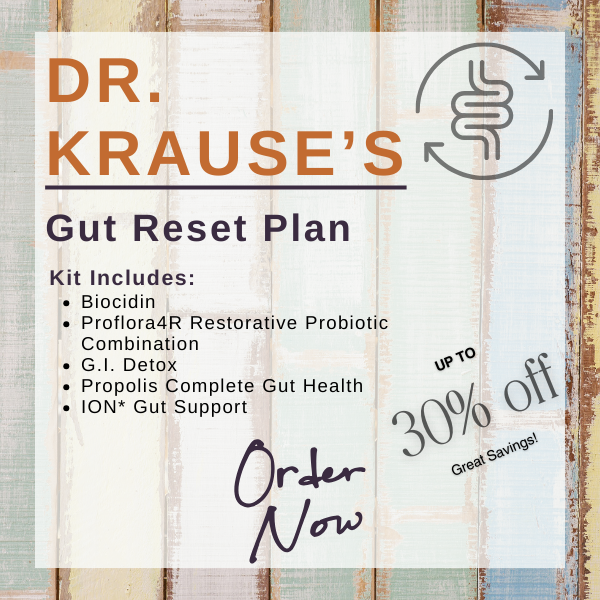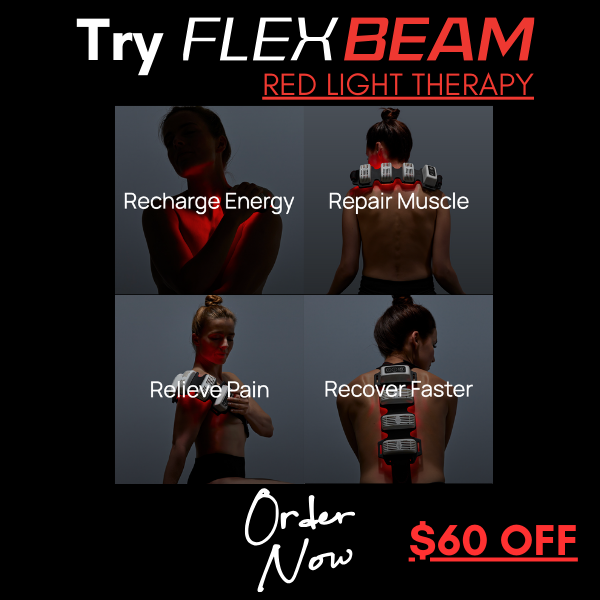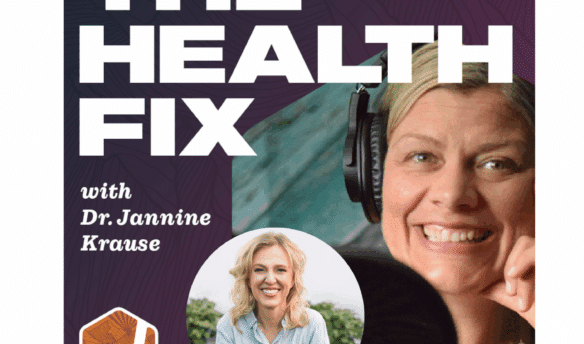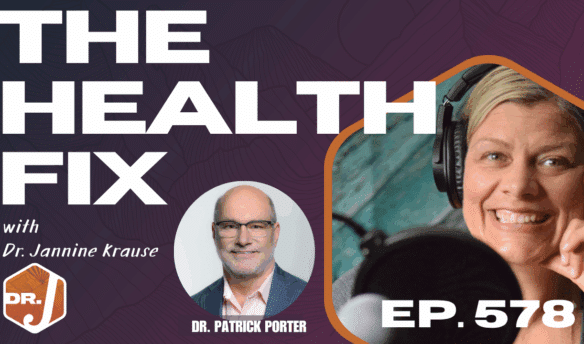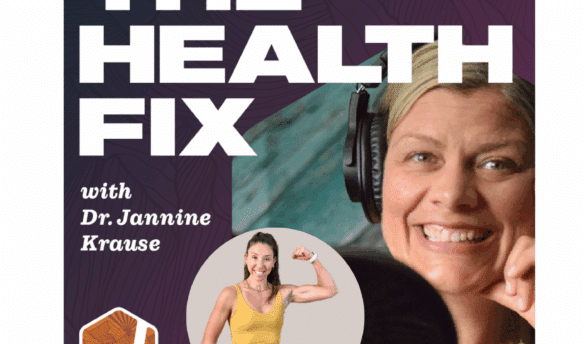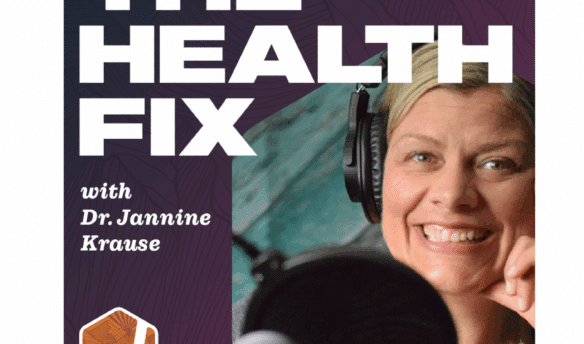Are stress, anxiety, fear or anger hijacking your ability to enjoy life to the fullest? Looking for a tool that can accelerate your stress management process? Brad Yates is known internationally for his creative and often humorous use of Emotional Freedom Techniques (EFT), also known as Tapping. He’s the author of the best-selling children’s book “The Wizard’s Wish,” the co-author of the best-seller “Freedom at Your Fingertips,” and a featured expert in the film “The Tapping Solution.” He has also been a presenter at a number of events, including Jack Canfield’s Breakthrough to Success, has done teleseminars with “The Secret” stars Bob Doyle and Dr. Joe Vitale. With over 1000 videos of tapping on Youtube Brad has something for every mental health dilemma that arises. In this episode of The Health Fix Podcast, Dr. Jannine Krause interviews and taps with Brad Yates on releasing resistance, self sabotage and preventing the stressful emotions from hijacking your health and aspirations in life.
Dr. Krause’s Protocols
Instructions Included
Traveling soon? Looking to detox or reset your gut? Try one of Dr. Krause’s Fullscript plans.
What You’ll Learn In This Episode:
- Down regulating the emotions of fear, stress, and anxiety in the body with tapping
- Why reducing resistance is crucial for dealing with stress & changing your mind
- How EFT (Emotional Freedom Technique) tapping sequence works
- Subconscious programming of hanging onto fear and it’s connection to resistance and safety
- Why tapping of any type is beneficial & you can’t mess it up
- Incorporating tapping into your morning routine
- How self sabotage is misguided self love
Resources From The Show:
- Brad’s website – tapwithbrad.com
- Tap with Brad on Youtube
- Brad’s Free 5-day program “Tapping Into Your Best Self” – www.tapwithbrad.com/bestself
- Watch on Rumble HERE or on Youtube HERE
Our Partners
Podcast Transcript
2:20 – How did Brad get into EFT?
4:32 – What is EFT? Similarities to acupuncture
13:26 – Is it imperative you speak the words out loud or can you just speak them in your head to get the benefits of tapping?
17:52 – About Brad’s 5 day program
22:08 – Working with people that have insecurities about mind and body
26:10 – Brad’s energy hygiene protocol
28:05 – Breaking free from the matrix and old programming to create change
34:20 – Importance of self love
39:20 – How does tapping help with resistance in the mind
47:43 – Examples of athletes that are using tapping
49:56 – Brad gives an example of how to use EFT/tapping so you can tap along
105:15 – Where you can find information about Brad’s programs
Welcome to the Health Fix Podcast, where health junkies get their weekly
fix of tips, tools and techniques to have limitless energy, sharp minds and fit
physiques for life.
Hey Health Junkies, on this episode of the Health Fix Podcast, I’m interviewing Brad
Yates. Brad is known internationally first creative and often humorous use
of the emotional freedom techniques, EFT, otherwise known as tapping, and that’s
I found him in the first place. He’s an author of the best-selling children’s book, The Wizards Wish,
the co-author of the bestseller Freedom at Your Fingertips, and a featured expert in the film,
The Tapping Solution. Brad has also been a presenter at numerous events, including Jack
Canfield’s Breakthrough to Success, has done telesaminars with The Secret Stars, Bob Doyle,
and Dr. Joe Vitale. Now, he has over a thousand YouTube videos of himself tapping for pretty much
every single mental health thing you could think of. And in this episode, Brad and I are going to
chat about releasing resistance, self-sabotage, preventing stressful emotions from hijacking
your health and really your aspirations in life. And gosh, I’m excited about this one because
I’m a huge fan of Brad’s. So let’s introduce you to Brad Yates, EFT tapping and tapping into your
best self. Alright, let’s get on with the podcast. Hey, health junkies. I can’t contain my excitement
anymore because I get to tap with Brad today, which Holy cow has been a dream of mine for I’d
say probably three years since I found Brad. And so today we’re going to be talking all about
emotional freedom technique, aka tapping and how Brad got to this and also how we can become
our own best selves using EFT tapping. So Brad, welcome to the health fix podcast.
BRAD: Thanks so much, Deena. I’m happy to be here with you.
JANNINE: Man, you have no idea. This is like, this is dream come true for me right here. So of course,
you know, I love to start off my podcast on the always question of like tapping. How did you get
into it. What brought you to it? I mean, we talked about clown college, which don’t worry,
we’re going to get to that too. But I want to know about tapping. What brought you to tapping?
BRAD: Yeah. How does a grown man find himself tapping on his face for a living?
Yeah. So I actually started out as an actor and I had traveled the world doing theater,
went to Hollywood to be a movie star as one does. And while I was there, I met a woman
fell in love and got married. And when our first child was on the way, I thought, you know,
know, I might need a backup career to support my family. So I saw an ad for hypnotherapy
school and I’d always been fascinated by the power of the mind. So I signed up and went
through that and started building a small hypnotherapy practice while still pursuing
my acting career. And then after a couple of years when our second child was on the way,
it occurred to me that as much as I loved acting, personal development work was my
calling. It’s like this fulfills me in a whole different way. And we left Los Angeles and
moved to Northern California to be closer to our parents
and had the kids close to their grandparents.
And through some other hypnotherapists,
I heard about this energy psychology conference
going on in Las Vegas.
And this guy doing this thing called EFT
or he’s tapping on his face and I thought,
“Sure, why not?”
And I know for those who may be new to tapping
and then the idea of tapping your face
may sound really weird, but as Janine said,
I’m a graduate of clown college.
So this was not the strangest thing
I’d ever been encountered.
So it’s like, sure I’m game.
So I learned this and in the first workshop,
tapped away at chocolate craving and realized,
wow, there’s something really profound
about this process.
And so I started introducing it
into my hypnotherapy sessions.
And then little by little they became tapping sessions
and it became my main modality for working with folks.
JANNINE: Oh, wow, wow.
I have found that it’s almost like, I can’t explain it other than the immediate reaction
your body gets to doing a tapping session. It’s almost like crack you like I need more,
and I’m just going to do more of this. And I like hypnosis. It’s fun. It’s good to kind of see
things, but the tapping in the moment, having that tool for when you’re like, I just need to
calm this roll down. It’s so huge.
BRAD: it’s the quickest simplest form of stress relief that i’m aware of that
that doesn’t include some kind of tranquilizer um you know for for those unfamiliar with it it’s
based on acupuncture so for thousands of years in chinese medicine they’ve said there’s a flow
of energy through the body along these pathways called meridians and when the energy isn’t flowing
naturally we experience our natural state of health and well-being physically and emotionally
when this energy gets blocked or disrupted, then we don’t feel so good. We don’t think as clearly,
we don’t make the best choices. So that has all kinds of unfortunate consequences.
So in traditional Chinese medicine, the doctor is sticking needles in these key points around
the face and torso. And actually, there are points all over the body. With the tapping,
we’re just using generally eight or nine points on the face and torso.
And it down regulates stress very quickly. So especially when you’re in a stressful situation,
It’s very difficult for someone to go, oh, I need to get myself in the hypnosis right now,
or I need to meditate right now, or I need to, whatever. But you can just start tapping
and start to calm that down. And yes, sometimes the effect is very profound and very quick.
Sometimes it’s not as obvious, but we have a growing body of modern research showing
through cortisol tests. It’s one of the stress hormones through FMRI studies showing the brain
activity. We have this, besides the anecdotal evidence, we have actual research showing that
this stress is being down regulated in the body through the tapping.
JANNINE: It’s so cool that we can literally tap into our own energetic fields. And being an acupuncture,
of course, that’s probably also why I was drawn to it because I’m like, okay, we know that small
intestine and this is this is small intestine in three point right you know so looking at that point
and going okay these were chosen for a reason now here’s my here’s my question that haven’t
had the chance to ask anybody and I’m wondering if you you’ve been um down any rabbit holes like
this have you done any of like what bent any of the the places where they’re doing the the fMRI’s
and they’ve kind of sequenced out why the certain specific points at the certain you know sequence
Is there is there a method to the madness there?
BRAD: That I don’t know about. The fMRI studies,
the ones that I’m aware of and there may be more have been done by my friend Dr. Peter Stapleton,
who’s a psychology professor in Australia at a university. But the points that we’re using were
developed by Dr. Roger Calahan around 1980 when he first came up with his process called
thought field therapy. So he’d been studying acupressure based on the classes that he was taking.
It started with a woman with a lifelong water phobia and after years of therapy and about
a year and a half with him, he was making some progress but not a lot and he was taking this
acupressure course. And he’s asked her one day, what is the physical symptom that you experience when
you’re disturbed about water and she says, “Well, I get a knot in my stomach.” And he said,
“Okay, so this particular point for the stomach meridian is right under the eye and just tapped
under her eye for a moment.” And she said, “It’s gone.” And he said, “What’s gone?” She said,
“The fear and ran towards a swimming pool outside the house.” And he said, “Stop!” She was, “It’s
okay. I know I don’t know how to swim because she’d had this fear all over her life, never learned
to swim.” But she got down by the pool and splashing water in her face and said, “I feel fine.” So
So naturally, he thought, well, that’s interesting.
And so he started experimenting with different patients based on these points that he had
been learning in his study of acupressure and came up with these eight points that he
would, depending on what the person was experiencing, he would come up with different algorithms.
He might use three points in different sequences, depending on what was bothering them.
And then one of his, well, within a year, he put himself out of business because all
of his patients coming to him on a weekly basis were like, I just don’t need to do anymore.
So he started teaching this process.
And one of his first students was a gentleman named Gary Craig, who had his degree in engineering
from Stanford, and thinking like an engineer, he’s like, okay, how do we simplify this?
Rather than trying to figure out which three points and which sequence, if we’re only
using eight points, what if we just go top to bottom in a row and found he got the same
great results. So he called this simplified version emotional freedom techniques or EFT.
JANNINE: Nice. Nice. Okay. So it all comes together for me now because I was wondering like,
mmm, is there something to this? And you know, I, I’ve tried doing kind of shorter ones when I was
in a hurry or like when I was trying not to, because I think one of your videos you’re saying,
like you can do this where people don’t necessarily know exactly what you’re doing. And so when I
But I was in my office, I was like, maybe I can try it to shorten it down and it did
seem to work.
But definitely the full sequence does seem to calm me better.
BRAD: Yeah.
And there are times where we may not be able to use all the points.
And sometimes we may just feel, I just want to stick on one particular point.
So like this kidney point right here, the collarbone, so the kidney is often associated
with fear.
it’s been said, there’s only two emotions, ultimately. There’s love and there’s fear.
So all the uncomfortable emotions have fear at their roots. So sometimes just tapping this fear
point can can down regulate whatever is disturbance. But there are times, there are times where I might
try to associate what I’m saying with a particular point. So, for instance, this bladder point is
associated with sadness, gallbladder associated with anger, stomach point associated with fear.
So I might do that. But there have been times where I might be experiencing a particular emotion,
but I’ll feel drawn to just stick to a different point that may not be exactly what that point
is associated with. So that’s the great thing about EFTs. We don’t worry too much about that
because the mind is complex, our body is complex, our emotions are complex,
so rather than just going, “Oh, I know exactly what the emotion is. I know exactly which point to tap.”
Trust your gut. And sometimes you might find, wow, I just feel like tapping this this other point, even though it may not line up with what I traditionally have heard about emotions and meridians.
JANNINE: That’s good to know. That’s good to know because I think a lot of people, you know, when they look at, okay, I got to get the sequence. Do I am I doing it right?
You know, and so which which is why, you know, I love watching your videos on YouTube because we can follow along.
but at the same time, sometimes you’ll be like, “Oh no, he’s talking and moved to this one.
I’m still at this one.” And so people think, “I’m doing it wrong. Oh no, it’s not going to work.”
BRAD: Any tapping that we do is beneficial. I mean, that’s the great thing about the research that’s
been done is we see these biological markers. We see the immune system being boosted.
We see cortisol decreasing. There are all kinds of different benefits that are happening,
whether we’re consciously aware of them or not. So even if we’re tapping along
going, I don’t feel any difference, like, okay, but we could hook you up to a machine and measure
biological markers and see and show you, yes, these benefits are taking place while you’re doing it.
But yeah, so any tapping that we’re doing is beneficial. Even if it’s just for a few moments
and you’re only tapping one point and you’re not saying any words, you’re still getting benefits.
So that’s one of the powerful things about it is to not worry about it.
And if you’re tapping different points, I’ve told folks, like when I do podcasts and it’s
just audio only, I always tell people, okay, I’m going to describe where the points are.
But as I go through that, I’m not going to necessarily say the points at the same time.
Don’t worry if you’re not on the same point that I am.
If you’re tapping, you’re doing benefit to your nervous system.
JANNINE: So good to know. So good to know. And yes, this podcast will be both video and audio folks.
So you guys can try it both ways and see what you think. You know, why not? Why not? Because
I think there is something like the first couple times. And so we might have some newbies here
that are like, EFT, okay, what is this business? You know, that maybe watching it for
the first time, you know, might be, might be important to just kind of see how it goes. But,
you know it is funny though like you had said that you might feel drawn to one particular spot.
I’ve actually gone through a whole series with you where I was just tapping on the same spot and
I didn’t repeat the words either because that’s something that a lot of people will say do I have
to say it out loud and I’m like no I feel like I can say it in my head and still get benefit.
I’ll let you speak to that a little bit.
BRAD: Well the thing about saying things out loud and saying
them emphatically is that we’re then more emotionally engaged. So the more we are experiencing the
emotion in our body, the more effective the tapping can be. But it is always been I believe
it is always beneficial. I believe that if we literally hooked ourselves up to these machines,
we would be able to see it’s like, okay, even though I’m not saying the words, even though I’m
in a different sequence, there are still benefits happening. But when we’re trying to address a
particular motion, the more engaged, the more we can tune into that. So it’s, you know, zeroing in on
it. So if you spill something on your carpet and you get the vacuum cleaner, you could just be
randomly vacuuming and you’re eventually going to clean the carpet, as opposed to, I’m going to
really focus right here on where I spilled the dirt or whatever. And so I might get, get it cleaned
up more quickly, more effectively.
JANNINE: Yeah, that makes sense.
And here’s the thing that I’ll share a little my personal story with tapping and maybe this
might resonate with someone, you know, for me, I like to talk things out, I’m a talker.
And when I need to talk things stuff out with my brain and how I’m thinking, I was also
drawn to the style of tapping that I could go, you know, say the things that I needed
to say, to just get it out. And that was the that’s been some
of the most fun parts for me. So that being said, how do you get
the right things to come out of your mouth? I swear every, how
many do you have to do multiple video takes of your tapping? Or is
this like you just flow?
BRAD: No, that’s the funny thing is because I mess up my words.
Sometimes I’ll be saying something and I’ll have to stop
And I won’t, and I won’t edit the video. If it gets really bad, if I’m totally tripping over, I’ll go, all right, I got it. I have to stop this. But in general, I like to just go in one take, because when I’m doing this tapping, it comes through me. It’s just an intuitive process.
us. And if I were to try to write down, okay, here’s the perfect script for this. And try
to memorize that or read it. I’d be tapping along and the muse would hit me and I’d be
like, no, now I want to say this. So I would keep changing it. So there’s no point in me
trying to script it. So I just trust that it’s going to come out. And it’s not always
perfect. And I’ll be tapping with a client. And I’ll say, I’ll make up some metaphor and
And they’ll say, yeah, that’s not really it for me.
And I’ll go, okay, I had an intuitive hit
and it may not be it for you.
It may be this is important for you
and you’re consciously trying to deny it.
Or it may just be this is just gonna trigger something
that’ll get there.
And I’m just gonna trust the judgment
’cause I don’t wanna center and say, well, I can only,
I’m only gonna say what I’m absolutely certain
is gonna be right ’cause I don’t know.
So I just try to not censor myself and go through with it.
and yeah, a lot of times it just comes out
and I start as gratifying on YouTube
when people comment and say,
“Are you in my mind?
“You are saying exactly what?”
(laughing)
Well, there’s just, we’re very similar.
We have a lot of the same thoughts and ideas
and so it’s just going with,
okay, what are the possible reasons
why I might be thinking this?
What are the possible reasons
I might be resisting that and things like that?
JANNINE: Oh, I’ve definitely thought that before too, for sure.
for sure, ’cause it does seem like you’re just in the flow.
It’s like, “Wow, he’s in my head, he knows me, he gets me.”
“Oh my goodness, it’s too funny.”
But it’s one of those things though with tapping
that I found as I’ve used it myself
and really becoming a new person.
That’s kind of what I was using the tapping for.
And you’ve got your five day program
of tapping into your best self.
And this is something that I’d love for you to talk about
kind of how this is meant to work for folks,
because I have found that for a lot of patients of mine,
if we can get them tapping, at least, you know,
for a week or so, I can get them to do it longer,
and it does speed up their process
of whatever’s holding them back.
So let’s talk about what was behind the five days
and all of that.
BRAD: Yeah, well, like what you were saying about the,
enhancing the healing process,
because most if not all of the issues that bother us physically and or emotionally
are caused by or worsened by stress. So when we have something to deal with stress, it allows us to
change things. We’re also very, we’re very addicted to the familiar. We don’t like change. We want
things to be different, but we don’t want anything to change and we don’t want ourselves to change.
So we keep saying I want to have this totally different life where I have a healthy body
and I have a lot more money and I’ve got this perfect romance and all that but I don’t want
to change personally. So I’m going to, you know, fit myself into this totally different
situation, you know, and, you know, imagine like taking a picture of you have this, you
you know, this winter scene and you’ve got somebody all
bundled up and closed and it’s like, okay, now I want to take
this image of a beach, but I want to put myself there, but I
don’t want to change my clothes. You’re going to be out of
place. And Dr. Joyce Brothers says, we will never perform
consistently in a manner which is inconsistent with how we see
ourselves. So what you were saying earlier, Janine, about
identity is so key. It’s our identity. So we think I want my
best life, but I want to stay the same. No, to be, I live your best life. You have to be your best
self. So I wanted to come up with a sort of a simple five day thing just to get the ball rolling
of looking at things like self forgiveness and self confidence, and really allowing ourselves to
see the awesomeness that’s inside. I have a, so you can see, well, those of you on audio can’t see
but on the wall behind me I have a picture of Michelangelo’s David. I have David’s everywhere.
On every wall I have a little statue here on my desk, which was always my favorite piece of
art. It’s the first time I saw it as a kid, but it’s also a perfect metaphor for this work because
Michelangelo said that the statues were already there perfect inside the marble,
and all he had to do was chip away what didn’t belong to reveal the masterpiece inside.
And to me, that’s a perfect metaphor for what we’re doing. Our best self is already there inside,
covered up by this marble that’s made up of self-doubt and feelings of unworthiness and guilt and shame
and anger and a lot of misinformation. And so the tapping is just chipping away what doesn’t belong,
clearing away those reasons why we can’t feel confident, why we can’t love ourselves, why we
can’t feel worthy. And as we chip away those misunderstandings who recognize,
“Wow, I am awesome. I am God’s gift of the world.” And it’s not an arrogant thing,
because as we see it in ourselves, we see it in other people, too. Arrogance is saying,
“I’m better than other people,” and that comes from a lack of confidence. It’s an insecurity.
But when we’re truly recognizing the awesomeness, the magnificence of who we really are, we see
another people too, and we want them to chip it away, and oh, if only you could see how awesome you
are.
JANNINE: Oh my gosh. Yeah, I feel like I’ve said that to a lot of people. Yeah. That’s why, you know,
tapping just is such a great tool. I mean, I definitely now use it in my office to help people
to kind of break through or move through. Because I do acupuncture, I’ll sometimes have
someone do it before we get the needles in. And then sometimes, I know, I’ll try to stack
in whatever I can. But one of the things I wanted to ask you about and see if you had any
experience with any clients or anyone you’ve worked with as women get older, we tend to have,
of course, like guys, some hormonal shifts that will make us feel like we’re crazy. Like we just
start to think in all of our insecurities can start to come up. And it’s not for everyone,
but it’s definitely for a lot of women, the insecurities about their body, the insecurities
about their mind, then not being able to think correctly. These things start to come up. Have you
worked with clients like this?
BRAD: Yeah, I’ve worked with people at all different ages. And yeah, and
always it’s, there are things that go on inside the body and the body body, mind is connected. You
know, we, the Cartesian splits of there’s mind and there’s body, never the twain shall meet,
is old news. So it’s recognizing that these things affect each other. So as our body is
going through things that does affect our mind and our brain and how that functions. So,
yeah, that’s one of the cool things about tapping is it’s such a simple process that we can allow
ourselves to calm down and down regulate all of that stuff and that the fear because what happens
is when we start to have, you know, maybe we feel some hormonal thing going on the body and trigger
something in the brain and our and our mind starts going down a path that it really is best if it
doesn’t go down. And then it becomes this cycle and it’s like, oh, now I’m worried and now I’m
pumping even more things and my midbrain is going into fight or flight. And prefrontal cortex goes
bye bye. I’m not thinking clearly anymore. And, you know, this, this is exactly what a lot of
advertisers want to do is they want to put you in this state of prefrontal cortex goes bye bye.
and you are now like, “Yes, what? Political campaigns, it’s all about getting rid of the
prefrontal cortex, get people really scared.” And that’s the thing is that it just takes us over,
so allowing ourselves to have a simple thing. It doesn’t take a lot of thought. I don’t have to
sit there and write down things and make lists and try to just allow myself to calm down and go,
“Okay.” And then I can start to think more clearly and go, “Okay, my mind is running away with myself.”
and these things that I’m thinking may not be true and I might be safer than I
think I am and we start to think more clearly again. So to me tapping ideally
is a daily practice. It’s energy hygiene. So like we have physical hygiene like
brushing our teeth and taking a shower. Most of us do it on a regular basis
before we need it. We don’t wait for a while until people are holding their
knows around us and going, oh, that’s right.
I haven’t taken a shower in three weeks.
Maybe I should do that.
But with stress, stress is always building up.
And most of us are carrying ambient levels of stress
we’re not even aware of.
Most of us are carrying a cell phone with us
that is constantly saying, here’s something else
to be upset about.
How you doing?
Well, I’m about to ruin that.
Did you hear about?
You know, and I’m the amygdala gets hijacked
and we get upset and we’re not.
And we just go, well, that’s just life.
That’s how it is.
not even recognizing how this, and especially if we are going
through some kind of hormonal changes, we’re even more susceptible.
And, and those kinds of triggers can be even more damaging.
So to allow ourselves to have some way of constantly, you know,
being in a, in a cleaner space energetically, then we’re,
we’re able to manage those, those life changes a little more easily.
JANNINE: Absolutely. Absolutely. You know, I, I like the idea of energy hygiene.
I might, I might steal that.
Um, I’ll give you credit.
Don’t worry, um, cause I’m looking at it going like, you know,
we talk about meditating, right?
Every morning.
And for a lot of people meditation is really this like concept of like,
what, I don’t know, I’m going to sit and make lists, at least for me.
That’s how it was for me.
I couldn’t get out of the brain.
It just kept coming in and telling me stuff.
But when I had something to do and say now it’s a whole different ballgame.
Oh, okay, I can do this kind of pseudo meditation thing,
you know, in terms of what I saw myself.
Now, so when you talk about energy hygiene,
what would be like,
or maybe just tell us what you do?
Like, do you do every morning
before you get out of bed, do you do a session?
Like, how does it work for you?
What’s your energy hygiene protocol?
BRAD: Yeah, so I have a whole morning routine
of exercise and things like that.
But it does start.
First thing is some tapping.
And for folks who are aware of EFT and say,
“Wait a minute, isn’t EFT just about getting rid of a problem?
Like if I feel stressed or I feel angry or I feel upset?”
And you start by tapping and saying,
“Even though I have this awful feeling,
I choose to love and accept myself.”
So Brad, you start every morning in a bad mood.
No, I don’t get up.
Even though it’s another morning and I feel like crap again.
No, the great thing about tapping is
we can tap while saying affirmations or prayers.
So like one of the first things I’ll do on many mornings is I’ll tap while saying the
serenity prayer.
Like rhyming the serenity to accept the things I cannot change is as I’m facing the day,
I want to get my energy system as balanced as I can so that I’m more open to what the
day brings and be at my best game, be thinking as clearly as possible.
So it’s not that I get up in a bad mood and I’m aware of anything there.
I’m just figuring, just in case there’s any part of me
that might be feeling some stress or resistance
that I’m not consciously aware of,
I wanna clear that out.
And it’s not like you can get too clear.
It’s like, no, no, no, you already have no stress.
Don’t tap anymore.
The floor is already clean, stop vacuuming.
There’s nothing so good, it can’t get better.
JANNINE: Right, right.
That’s so true, that’s so true.
And I mean, every morning, I think for a lot of people,
If you guys do continue to tap, you’ll find that it’s not as crappy of a morning.
If you had like a run where like a really stunk, I did find that, you know,
I was waking up for a good while, like in panic.
I’d wake up and be like, I have so many things to do.
Oh my gosh, I gotta check my email.
Oh my gosh, I gotta do this, this and this.
And then once I started tapping, it was like, all right.
So we’ve got the day, we got this kind of thing.
BRAD: Yeah.
Yeah, we have so much programming about how to respond to life and how I’ve
should be upset. We’re shooting on ourselves all the time. Other people are
shooting on us and we’re shooting on other people and recognizing in so much
of those, I should be upset about this. And especially we go on social media,
everyone else is upset. I should be upset too. And I should shoot on other
people and, you know, and create less peace. You can either be moving towards
peace or towards chaos and, you know, where do you want your
energy to go? So, yeah, having that, that simple way of
just going, okay, I want to be in that space and I want to be
creating space. And but yeah, we had that idea of I should be
upset, because part of this is afraid that we won’t be
motivated otherwise. We have so much programming about being
motivated by misery. And this idea of, you know, well, I won’t
healthy until the doctor tells me that I need to change my diet. So many people wait until it’s a
crisis. And because we’ve learned so many things that way, as children, maybe we didn’t clean our
room until our parents started yelling at us or, you know, or grounding us. And until there was
punishment, we didn’t do it. And so the only reason we would clean our rooms was to avoid
punishment. As opposed to recognizing a clean room makes my life easier,
not having to trip over toys and knowing where my things are and just being able to have space
to move around, environment is so important for our mental well-being. But as children,
we don’t know that. It’s something that needs to be taught. But most parents don’t know that
because they were never taught that. So rather than explaining to a child the virtues of a clean
room. It’s just like, just do it because because I’m going to, you know, I’m going to yell at you
or I’m going to spank you or I’m going to ground you or whatever and you get no dessert for a week.
So that’s why you should clean your room. Well, as soon as I’m grown up and I can go and eat
dessert whenever I want, why should I bother cleaning my room? And a lot of people are living
this way. It’s like without the threat of punishment, I’m not going to do that. So we might wake up
in the morning going, okay, I’ve got things to do. Well, I probably won’t do them unless I feel
You’ll, you know, some stress about that.
I need to feel some anxiety.
So, all right, kick in the cortisol, get upset.
Oh, yes, I’m gonna do this again.
All right, now I’m ready to start the day.
Now I’m properly motivated.
It’s like, you know, it’s the old thing
about the stick and the carrot.
And so many of us only believe in the stick.
It’s only the stick that’s gonna do it.
The carrot on its own is not gonna motivate me.
And that’s just resistance, it’s old programming.
If there was no resistance, we would move towards carrots.
We’d be so far ahead of the stick.
It’s like, I don’t even need to worry about that
because I’m so motivated to go for these things.
But the resistance is there.
You know, we’re always running cost benefit analysis
when whenever we’re looking at some activity
or some goal in our minds, we’re running through going,
okay, what are the pros of reaching that goal
and what are the cons?
If I have, if I’m trying to get healthier,
what are the pros of being healthier?
Well, I’ll feel better in my body.
You know, I might look better and I might enjoy that.
What are the cons?
Well, I might have to give up eating pizza
three nights a week,
and I might have to lower my alcohol intake,
and I’m gonna have to exercise.
And I’m weighing that out, it’s like,
yeah, you know, looking good in a bathing suit
is not that appealing to me,
that I’d have to give up whatever else this is.
And so, and then we’d beat ourselves up,
And we say, I’m so lazy and it’s just not true.
We’re not lazy, we just have resistance
based on old ideas of exercise is painful.
There are people, you go to the gym and you see them
and they’re in bliss doing something
that you think is painful.
So it’s just mindset.
Eating healthier, we have this idea from kids,
it’s like, can be good, vegetables bad.
Vegetables are awesome.
There’s some vegetables I’d rather eat than sugar.
And you know, depending on how it’s prepared, things like that.
So but we have all this old mindset that’s running our lives.
And then we have a, when we try to change that, we have a stress response.
So Gee, if we only had some way of dealing with stress and we could help ourselves change
our minds, and then we’d clear the resistance going, oh, exercise can actually be fun.
You know, I have, I have a VR headset and I do these exercise programs in, in a virtual
reality world and it’s absolutely blast. So I’m working out and having fun. So there’s
all kinds of different ways of change that mindset. So now I don’t have to wait until
the doctor says, look, you have to change your routine or you’re on your way to an
early grave. It’s like, no, here’s what’s possible having a healthy body and being able
to live life fully and and feel that your body can support you in that. It’s like, yes, that’s so
awesome. I and without any resistance, of course, I’m going to do that.
JANNINE: Yeah. Oh, my goodness. Yes,
just that that concept of minimal resistance and reducing the resistance is is so huge.
So huge. And with the tapping, that’s definitely one of the things that I found that for me,
it was one of the most beneficial things. I, you know, back in the day, I found Jessica,
I can’t, I think Orttner, maybe is her last name, her book. Yeah, yeah, for the, the weight
loss and, and helping me there. And then I kind of, of course, moved into working on your stuff
to help with the mind and, and really understanding this journey of, of becoming me. And so I can
see your five day program for folks being incredible for them to kind of either launch the new them
or really just get a good solid foundation for becoming their new new self.
BRAD: Yeah, starting to recognize how awesome you are, how deserving you are of the best life.
You are worthy and deserving of the best this world has to offer. And when you allow yourself
to recognize that, life gets so much better. But it’s just it’s a matter of clearing that
resistance and just record. So the extent to which we don’t have, well, what we say we want
tends to be the extent to which we’re resisting it. And we resist it because of
old misunderstandings. You know, we might have old beliefs about why it’s not safe to be healthier.
We might have old ideas about why it’s not safe to have more money. You know,
people, everybody says they want more money, but if you get right down to it and you ask them how
safe it feels. And it’s like, Oh, well, I do have this belief that money is the root of all evil and
rich people are greedy and all this. And I don’t want to be a greedy bad person. And I don’t want
to be evil. So we unconsciously stop ourselves from having the money that we want. And and it’s
brilliant. We beat ourselves up and go, I’m so stupid. It’s like, no, self sabotage is simply
misguided self love. Even though the action you’re taking seems to be moving you away from what you
consciously say your goal, it’s an act of self-love because some part of you believes it’s not safe.
If I’m afraid of the consequences of being healthier or having more money or traveling or
whatever it might be, part of me is helping me dodge a bullet by making it impossible to reach
those goals. So we want to be compassionate with ourselves and go, thank you so much for trying
to protect me in old outdated ways that are no longer serving me. Now we’re going to truly make
life better in much healthier, more rational ways.
JANNINE: It is incredible how we will hold on to what we
subconsciously believe is safe. I find it’s just like, wow, all those things we will do. I know
you know, I did it for years, years.
BRAD: Yeah.
And when we’re eating junk food,
you know, we might objectively realize,
okay, there is nothing good for my body in this.
You know, my taste buds are the only part of me
benefiting from this.
And my mind, because I have this belief about, you know,
well, this reminds me of happy times.
And in that moment, we may be thinking, okay,
we might’ve had a bad day at work,
and I’m just feeling uncomfortable.
And my mind says, you know, it’ll make us feel better.
And so it’s an active self-love.
And even though we could objectively say,
this is so bad for me, but it’s like, okay,
as far as the immediate concern
of not feeling good emotionally,
this is what’s gonna feel good for me.
And I know that later I’ll have to deal with consequences,
But that’s later.
Right now, I can’t deal with consequences right now.
So it’s really being compassionate with ourselves
for trying to take care of ourselves.
But that uncomfortable feeling is that stress response
to whatever’s going on.
And tapping is a very quick way to start
to deal with that and go, oh, even before I open the box
of cookies, I’m starting to feel more calm.
I’m starting to feel better.
And maybe, maybe I don’t need any cookies right now
or maybe all out myself a one or two.
but then I don’t need to eat the whole box.
JANNINE: That is definitely what I definitely use
tapping for back in the day.
I mean, I had to, right?
You know, it’s a great pattern interrupt,
but it’s also a great way to get us out of that loop.
But too, I feel like it’s a great way
to get yourself out of that.
So we’re gonna take a brief break
and let folks know a little bit more about your program
and then we will come right back.
[Advertisement] Hey Health Junkies, whether you’ve been tapping for a while
or you are interested in tapping
and you wanna test it out, I highly recommend
checking out Brad’s free five day program,
tapping into your best self every single day.
You’ll have a tap with a mission and it’s good stuff.
I’ve done it myself, I really do find it helpful.
And boy, it is a great way to really get started
on becoming the new you.
So go to tapwithbrad.com/bestself.
That’s B-E-S-T-S-E-L-F.
And you can get his free five-day program now.
Let’s get back to the podcast.
[JANNINE] All right, we’re back.
So one of the things I was really wanting to talk about
is resistance and resistance to change, resistance.
You know, just in general,
and I know you’ve tapped on it before.
I’ve seen a couple of sessions share with us a little bit
about how you can use tapping to help
with resistance in the mind.
BRAD: Yeah.
So when we are facing something that well,
that we consider a threat.
So the amygdala and the midbrain perceive things as threats
and tries to avoid that.
You know, we want to run away from things that are,
that we see as unsafe based on our beliefs.
And it happens at an unconscious level so often.
we may be going, I don’t know why I’m where I’m at.
How did this happen?
Because I said I want it to be over here
and I’m over here.
That’s because at an unconscious level,
we’re making all kinds of little decisions to avoid,
to resist something that we perceive as a threat
based on our programming.
So like I said, the idea that money is the root of all evil,
which is not the actual quote.
The actual translation is the love of money
is the root of all kinds of evil.
And, but it’s been narrowed down to money
is the root of all your money is bad.
So we had this belief.
And so when we have an opportunity,
an opportunity to have more money,
like we were a interview for a job
that would have a great paycheck,
we might just forget to go to that interview
or we might totally blow it.
And it’s not that we’re bad or stupid.
It’s that some part of this is saying,
look, this is not safe.
That would be too much money.
That would make us a bad person.
It would make us evil.
And this is all happening at this unconscious level.
Consciously, we create our dream boards.
We say, oh, this is what I want, the house on the beach
and the Lamborghini and all that.
And our unconscious mind, which is 80% to 90% of our mind
versus 10%, 20% of the conscious mind,
is saying, that’s fine.
You go ahead and fantasize about that.
But we’re going to make sure that it doesn’t happen
because it’s not safe.
So that’s why we resisted.
And, but that, that resistance just comes up in,
in our energy, in that stress.
So that we feel uncomfortable and we move away from it,
just like touching an electric fence.
Oh, that’s bad, that’s a shock.
Let’s move away and go to the other direction.
And so tapping is like cutting the wires on the,
on the electric fence.
It doesn’t make us stupid.
It’s not like, you know, if there’s an electric wire
there to protect us from falling off a cliff,
not like I cut that wire and go, “Oh, now I can fall off the cliff.” We get this idea that I can
only avoid danger if I’m in fear mode. It’s only if I’m scared that I’ll make good choices.
And so that’s why we hang on to these fears. But most of us walking down the street and we come to
a crosswalk and we push the button and we wait for the little green man to show up for us to walk
cross and and we might still look both ways. I do that on my morning walk every day. I look both
ways because there are a lot of people who whip right through even though the crosswalk sign is
is lit so but I don’t have to stand there and go all right now to make sure that I look both
ways and to make sure I wait for a little green man I need to get myself worked out okay hearts
pounding sweat pouring out okay now I’m ready to cross safely it’s like no I can be totally chill
and still remember it. It’s like, it’s like I’m relaxed and go, well, I’m totally relaxed. I think
I’ll walk out into traffic. So it’s allowing ourselves to recognize that we don’t need that
fear response. Now, it’s beneficial when it happens, you know, and there are no negative emotions,
anger, fear, it’s like a smoke alarm. We want it there so that when it’s there to let us know
there’s something to be addressed, but it may not be a fire. It’s just let us know, pay attention,
but once we recognize, we see the fire and go to put it out, the smoke detect doesn’t have to
keep going off. The alarm doesn’t have to keep going. And we so often hang on to that. I was like,
no, I don’t need to and I don’t want to act from that fear or that anger. You know, we don’t want
to say, oh, the alarm’s going off. Oh, I have to go into the kitchen and oh my god, there’s a fire
and I start trashing everything and I’m going to throw the you know push the the stove over and
all this because I’m reacting out of this like no the anger or the fear or whatever that emotion
is there is there let me know it’s like okay now I want to think of what is the best remedy
for this situation so yes so that that fear response comes up and and tells us back away
move away from this and go in another direction. So the tapping helps us to calm that down so
that we can look at it and say, “Is this something that’s really dangerous? Would it be dangerous
to have more money? Would it be dangerous to be healthier?” You know, I can handle it.
It’s getting to that place of recognizing, “I can handle this. I can handle things being better.”
JANNINE: Yeah. Well, and you mentioned that I’m starting to think of different scenarios I’ve seen with
with patients, especially with the fear turning to anxiety,
turning to back to fear.
And especially when you’re midlife in anything with the heart.
I feel like any heart palpitation, any little blep,
anything there can go from zero to like 60 real fast,
it seems.
BRAD: Yeah, when I’m out for a run and I might feel
something in my left arm, it’s like,
“Oh my goodness, my left arm, I’m running too hard.”
(laughing)
JANNINE: It’s crazy how we can go–
BRAD: Calm down.
I mean, it’s good to pay attention, but you just want to pay attention.
So I, I stop and I’ll go, okay, I don’t know what that is and may, it may be related to
the heart.
It may not, but I’m going to pay attention.
I’m going to just take it easy here and I’m going to make good choices without going,
I’m going to get on my phone and call my wife and say, you’ve got to come out and drive
out and find me and pick me up.
So we’re able to get to a place and make better decisions and in that more calm place,
I could also– if it was something more,
I could say this is something to be concerned about.
Maybe I should call my wife and have her come find me.
JANNINE: That’s, I mean, important thing to say, of course,
I think a lot of people are gonna think like,
can I tap and override my internal intuition?
And you just spelled it out right there.
BRAD: Yeah, no, your higher wisdom is there.
You don’t, we can tap away fear,
but we don’t tap away intelligence.
We don’t, you know, we don’t lose our common sense.
JANNINE: Important, that’s important.
Plus I think it also helps us to kind of narrow,
like you said, narrow me down to a need to call the wife,
do I not need to call the wife?
You know, I imagine you out running, you know,
do you run a lot, like multiple miles?
What’s your story with running?
BRAD: Well, not anymore, I used to.
At this point, I mostly do walks
and sometimes I’ll run for parts.
I’ll do interval training and I’ll run for certain parts.
And then it’s like, if I notice,
all right, that feels uncomfortable, then I stop.
Because I’m, you know, in my age,
I’m not trying to win any Mr. Universe Awards
or impress anybody.
It’s like, I just wanna be healthy enough
to be able to do what I wanna do.
JANNINE: Sure.
BRAD: So I don’t push myself any harder than, you know,
exercise regularly and I at least had to do the VR workouts where it gets the
heart rate up. So I do all those things to be healthy but I don’t I don’t wish
it.
BRAD: Well you know there comes a time where we just you know know what we want
to do and what’s what’s important to us and so I think for a lot of people too
maybe we have some athletes listening here. I was visioning you like running
and tapping. You know, I have been out, no joke. I’ve been out and tapping while on a hike,
just because some stuff has come up and more emotional stuff that popped up out of nowhere
on the hike. But I would imagine that some folks might actually use this in a sporting
situation, maybe before a run, you know, something of that nature.
BRAD: There’s a video footage of an Olympic runner tapping just before his race.
There are top-level athletes, I know of Super Bowl winning teams that used tapping, World
Series winning baseball teams that used tapping.
I have worked with people at the highest levels of music and film.
So there are people in all kinds of different realms,
but definitely I’ve worked with a couple
of the Olympic athletes on just up in their game.
And it’s like, you know,
if there’s any resistance stopping me
from being the best at my sport,
I wanna clear that.
And we have all kinds of reasons why we might.
There may be a fear of being the best.
There may be a fear of pushing it and finding out,
there’s a part of us that’s afraid
of finding out what we’re capable of.
’cause man, if I really knew what I was capable of,
the expectations on me would be so difficult.
So, you know, if I, I’m living high on lowered expectations.
You know, people don’t expect much from me.
I get to breeze through life.
Oh sure, I don’t get to experience everything in life
that I say I want, but, you know,
there’s a part that clings to that.
It’s like, even if our lives are crap, it’s my crap.
I dealt with it yesterday.
I know how to deal with it.
I can deal with it again today, but something new,
something that objectively might be better,
it’s still different, and I resist that.
So yeah, tapping is a great way to look at
what are those things that were resisting
and down-regulate the stress, clear the resistance.
So it’s like, ooh, I will have that, thank you.
And I do have what it takes to get it.
BRAD: I love that concept.
So I love the concept of just thinking about all the different things in life that we probably
do have resistance to and what we could do if we cleared it to move forward.
So I would love, love, love to tap with you today on resistance and let’s give folks,
you know, something really good that they can use to try out and see if they can start
ticking off little things that they’ve been resistant to no matter what they’re talking
about, whether it’s sports, life, food, whatever.
BRAD: Yeah, absolutely.
So first I’m going to give a quick demonstration, especially for those of you, for those of
you who are new to tapping and I’ll explain it for those who are listening just on audio.
What we’re going to do is take the fingertips of our index and middle finger and the meridians
run up and down both sides of the body.
And so you can tap with either hand or a lot of people tap with both hands at the same
time.
So we’ll take the fingertips for demonstration of your dominant hand and gently tap on the
edge of your opposite hand.
So right between your wrist and your pinky on the edge of your hand, gently tap in there.
And that’s where we’ll use, say, the setup phrase.
So the setup phrase is whatever we’re aware of that we’re trying to get rid of, or at
least trying to process, getting rid of emotions so much as processing and moving through them.
as I said, they serve a purpose,
but we want to get through the discomfort.
So if it’s, I’m feeling stress
or I feel this tension in my shoulders
or I’m nervous about this report that’s due next week
or I’m really angry at Bob
’cause he was a real jerk this week, whatever it is,
that’s the setup phrase, this stress, this angry Bob.
And we’d rate that on a scale of zero to 10
just to get an idea of how upsetting is it for me, you know, it may just be a four, I
may not be terribly bothered, it may be an eight. And, and we want to ideally be aware
of how we feel it physically, so that we’re really aware of, okay, this is, I’m angry
about it’s, it’s in my shoulders, and it’s about an eight. So we would tap on the side
of the hand and say, even though I’m angry about, I choose to love and accept myself.
We repeat that three times, and it’s just a level of self acceptance, while we have this
issue because most of us are programmed to avoid what’s bothering us and what we resist
persists. Even when I introduce you to folks and I say, start off by saying, even though
I feel this stress, what you talked about this stress is you got to do positive thinking,
you got to focus on the positive. You can’t say what the bad thing is. So if you break
your arm, you’re going to go to the doctor and say, let’s talk about my legs. My legs
feel really great. You know, if your dog poops on your carpet, you’re going to say,
I’m going to look at all the clean parts of my carpet and just talk about how beautiful my carpet
is. You got to look at what’s there and deal with it. And that’s what we’re doing with the tapping.
We’re not just dwelling on it and commiserating over it. We’re just looking at here’s what’s going
on and here’s what I want to address. So that’s the setup is tapping on the side of hand saying,
even though I have this issue, I choose to love and accept myself. Then we go through these points,
right? The first point is right at the beginning of the eyebrow. So right near the center of your
face and just gently tap in there, and we generally tap these points between five and 10 times.
Depending on the length of the setup phrase, it might be longer. So then while tapping there,
we’d say the setup phrase, this stress or this angry Bob,
follow your eyebrow out to the side of your eye, so the outside corner of your eye socket.
and gently tap in there and repeat the phrase all this stress right under the
middle of your eye just above your cheek all this stress right under your
nose just above your upper lip all this stress then right below your lower lip
just above your chin all this stress the next point is the collarbone point so
if you feel your collarbones just about meet there’s a little bit of a u-shape
at the base of your throat and you can tap with all of your fingertips or you
you can make a fist and tap right over that area. All this stress. Next point is
about four inches below your armpit. It’s right about bra strap level and I’m
sure even the guys can figure out where that is. All this stress and then find the
top of your head. So with all of your fingertips tapping around the crown of
your head, all this stress. Then you take a deep breath and you check in again and
say, “Okay, how much stress is there now on a scale as you’re at 10?” And sometimes
it’ll go from an 8 to a 0 like that. Sometimes it’ll just go from an 8 to a 7.75, and that’s still
beneficial, but also it’s often like peeling the layers of the onion, so I may say, yeah,
I’m still feeling some tension in my shoulders, but now I know why. This report that I was nervous
about, now I know exactly why, because I got this bad grade on a report in the third grade,
and I never forgave myself for that, and I’ve always been nervous about reports since then,
and now I can clear up decades of stress that I’ve been carrying. That’s great.
So those are the basic points. As we go through them in this round, I’m not going to say the points,
so I’ll mention where we start with the side of the hand, and then when we switch to the eyebrow,
for those of you who listen to audio, and then just go through the points as best as you remember
them. Don’t worry as Jannine and I were talking about earlier. Don’t worry about being on the
same point that we’re on, any tap you’re doing, even if you’re just tapping the same point,
that’s fine. And then you can go back and watch videos later and see, oh, okay, there’s where
the points are. So what I’d like you to do is close your eyes, take a deep breath.
And I want you to think about something that you say that you want.
it may be a certain level of income, it may be a certain level of health, you know, you may have
a fitness goal, I want to be able to run five miles, you know, it may be some career goal
and maybe a relationship goal. Think about something that you’ve been saying you want,
I mean, maybe something you put on your vision board and imagine having that as best as you can,
can’t imagine you have it.
And just feel what goes on inside your body, say,
it’s safe for me to have this.
And let that rattle around inside.
And notice on a scale of 0 to 10, how safe it feels.
Now, part of you is going to might try to say, oh, it’s
definitely a 10.
And I’m going to challenge you on that.
Because if it was a 10, either you’d
have already achieved it or you would be well on your way
and wouldn’t need to be working on it,
doing tap on our resistance.
Now say it’s okay for me to have this goal.
I deserve to have this goal.
And rate those on a scale as you’re to 10.
And don’t judge yourself harshly
if the number is lower than you’d like it to be.
Just allow yourself to see, oh,
if it’s not a 10, I have resistance
and allow yourself to be aware
of where the resistance might show up in your body.
You might feel some discomfort somewhere
as you imagine these goals.
Be aware of any thoughts, beliefs,
or memories that might come up as to why you couldn’t
or shouldn’t.
It’s like, oh yeah, it’s nice to fantasize about that,
but your best friend would hate you if you had that.
Then you don’t want your best friend to hate you.
So that’s where the resistance would come up.
Don’t worry about it.
If you’re not consciously aware of the resistance,
just notice what you can.
Take a deep breath, open your eyes.
So we’re gonna start by tapping on the side of the hand.
So just tap where I run tapping
and repeat back what I say.
And I don’t know, Janine, you can say it out loud
or for the purpose of the video,
I know a lot of hosts don’t.
For everyone else,
I encourage you to say it out loud
and if you’re in a position where you read in.
So tap on the side of hand.
Even though I might have some resistance,
I choose to love and accept myself.
Even though I might have some resistance to this goal,
I choose to love and honor myself.
Even though I might have some resistance to this goal.
And pardon me, resist saying, Matt.
I don’t have any resistance to this goal.
I am totally on board with having this happen.
And every single day, I’m doing absolutely everything I can to reach this goal.
And maybe part of me says, “No, I’m not.”
And that might be because I have some resistance.
and even though I might have some resistance to this goal,
I choose to deeply and completely love, honor,
and accept myself.
And maybe anyone else who contributes to this.
So tap in the eyebrow point, all this resistance,
and then we’ll just go through all these points side of the eye,
all this resistance.
All this resistance to receiving this goal, all this resistance to achieving this goal,
all this resistance to admitting I have any resistance, because that’s a brilliant way
to resist getting it.
If I convince myself that I have no resistance, then I won’t address that resistance.
And I get to safely avoid reaching this goal.
Because part of me says, it’s not safe to reach this goal.
It’s safe to fantasize about it.
It’s safe to put it on my vision board.
But if I’m not doing everything I can to get there, I choose to be open to the possibility
that some part of me is afraid of reaching this goal, and I’m protecting myself.
If I’m not doing everything I can to reach it and maybe I’m doing things that move me
in the opposite direction, it’s not that I’m bad or stupid, it is not that I am weak
or lazy, it’s just evidence that I have some old programming about why I couldn’t or shouldn’t
reach this goal. That why it might not be safe for me. Am I afraid I couldn’t handle
the consequences? I couldn’t handle the changes in my life. People might be envious. They
They might be mad at me.
So I shouldn’t outdo them.
I shouldn’t have things better than they have.
So I brilliantly resist reaching this goal.
I love and appreciate those parts of me that have been resisting reaching these goals based
It’s on the belief that I need that to protect me.
And now I’m processing those fears.
All these fears of the consequences.
All these fears that I couldn’t handle reaching this goal.
All these fears that I don’t have what it takes.
I’m clearing those fears at a cellular level.
Clearing them all the way back through my past.
Back through all the times in my life.
That I somehow got the message.
That I couldn’t have this.
That I shouldn’t have this.
Those are misunderstandings.
The truth is, I’m a magnificent child of the universe, worthy and deserving of the best
this world has to offer, and I’ve got what it takes to do what it takes, so I’m clearing
that resistance, releasing it from every fiber of my being. So that when I think about
this goal, I feel really good about it. I know I’m worthy and deserving of it. I know
that I’m just the sort of person to have this. And I’m loving myself in the process, in
body, mind, and spirit, and take a deep breath. Close your eyes, go inside, and think about
that goal again, imagining that you’ve achieved this goal, that you have these circumstances
say, it’s safe for me to have this. It’s okay for me to have this. I deserve this. And hopefully
that feels a lot better. That feels more true. And again, like peeling layers of the onion,
there may have been memories that came up, different faucets came up or different sensations
that came up. And you can address those more specifically with tapping and keep clearing
away that stuff that gets in the way.
JANNINE: Gosh, that was awesome. That was awesome. I needed that today. That was like the perfect
one for me. I was like halfway through going like, yes, yes, I needed this. Definitely some
resistance about me and me in the podcast, you know, and trying to move things forward. So
this is good. This is good.
BRAD: Excellent.
JANNINE: Awesome. Brad, my goodness. What a pleasure to be able to
interview, but also tap with you. Dream come true here for sure. Loving it. So of course,
So we got to tell folks like how can they get a hold of the five day free program Tapping Into
Your Best Self and then also following you on YouTube, tapping the thread. I’ll let you speak.
I’ll let you give the spiel versus me.
BRAD: Thanks Jannine. Yeah. Easiest way is to go to tapwithbrad.com
and on my website, you’ll see the opportunity to get that free five day program tapping your
best self or another five day program that I have called Success Beyond Belief.
So all kinds of great resources there to help you start tapping and clearing away that resistance
and recognizing how awesome you are and how awesome a life you deserve.
And then yeah, I have well over a thousand videos on YouTube on all kinds of different
subjects, whatever’s coming up for you, there’s probably a tap for that.
And yeah, please, please use it in good health and allow yourself to feel better about yourself.
and then you’re able to do things better and create a better life and that’s good for you
and countless others. So thank you for doing that.
JANNINE: I love that you always mention the benefit
for others by folks working on their tapping and their energy and of course it’s just such a big
deal for us to be thinking about the impact of how we impact the other the folks around us
and our environment.
BRAD: We are a gift to the world and that’s why one of the job titles I gave myself
is gift unwrapper. It’s unwrapping. It’s just like Michelangelo with the David. The David
is a gift to us. It’s just a magnificent piece of art. Michelangelo unwrapped it. So,
helping people unwrap the gift and sharing it. And, you know, if we make the world a better place,
that’s good for us. We can’t sit there and just take care of ourselves and hope that the world
will somehow help us out. No, we need to make the world a better place.
JANNINE: Absolutely. Absolutely. One tapping session at a time is how I will throw it in there.
BRAD: There you go. There you go. Making the world a better place one tap at a time.
You got it. My goodness. Thank you so much, Brad, for coming on and sharing all of your
knowledge with us. I sincerely appreciate it.
BRAD: Oh, thank you, Janine. I appreciate the opportunity. It’s great to meet you.
And thank you to everyone who’s been willing to tap along with us.
JANNINE: Absolutely. [Outro] (Upbeat music) Hey, fellow health junkie. Thanks for listening to the Health Fix podcast.
If you enjoy tuning in, please help support me to get the word out about the podcast,
subscribe, rate, and review, and just get that word out. Thanks again for listening!
